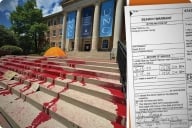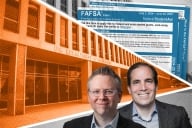You have /5 articles left.
Sign up for a free account or log in.
Private colleges are continuing unabated their strategy of setting high sticker prices while giving most of their students steep discounts, according to the latest survey of private colleges by the National Association of College and University Business Officers.
The colleges, many of which are struggling to meet enrollment goals, are taking in only 54 cents for every $1 they claim to charge in tuition.
The “high tuition, high discount” business model is often confusing to students and parents, but it’s how things are done at most private colleges: the colleges charge high prices and then offer students they want huge discounts. The discount comes in the form of need-based aid for low-income students and “merit” aid for students with characteristics that make them desirable to a college. At wealthy colleges, endowments may have actual funds to replace lost tuition revenue, but most colleges are just waiving the chance of getting more.
This so-called discount rate – the college’s aid dollars as a percentage of tuition and fees – is again at an all-time high.
In fall 2013, the average discount rate was 46.4 percent for first-time, full-time freshmen, according to NACUBO’s survey of 401 private nonprofit colleges. The discount rate is up from 44.8 percent in 2012 as 47.9 percent of colleges in the survey reported enrollment declines, in part due to growing concern about college costs
A decade ago – in the several years before bad bets by the financial industry caused an international recession – the American college discount rate was just 38 percent at private colleges. (Public colleges do far less discounting, and the discounting they do is harder to track, according to NACUBO.)
Because of the discounts, the actual inflation-adjusted cost to students of a private college education has not gone up as dramatically as the sticker price that colleges purport to charge, according to data from the College Board.
Some private college business officers are beginning to wonder if this system makes sense.
“I think there are plenty of CFOs [chief financial officers] that are questioning the sustainability of the strategy,” said Natalie Pullaro Davis, the author of the NACUBO survey.
The discount rate itself doesn’t tell the full story because college can still cost students more even as the discount rate increases. The NACUBO report gives a simple example, based on a typical scenario: a college might charge $50,000 one year and give a student a 52.4 discount. The student pays $23,850. If the discount rate the next year increases to 53.5 percent, but tuition also goes up – by, say, 3.8 percent to $51,900 – the student is getting a higher discount but paying $24,134, which is more than the year before even though the discount is steeper. Colleges also fear certain scenarios with discount rates -- namely that a modest tuition increase coupled with a higher discount rate could mean a higher sticker price with no increase in net tuition revenue.
In recent years, a spate of small private liberal arts colleges have dramatically cut their sticker prices in an effort to, they say, tell the truth about college costs. Many of those efforts were also meant to boost enrollment -- making prices appear dramatically lower, while making little impact on the actual cost to students. Observers say it's too soon to know whether this strategy works in the long term.
Some consultants and financial aid officers argue that the generous aid packages are both good for business, because they can help lure students with financial aid awards that make it seem like the college is desperate to have them, and a rational way to redistribute costs, since wealthy families are often asked to pay the full price of college to subsidize those that cannot.
Just over 80 percent of college aid in 2012 went to students in the form of need-based – rather than merit-based aid – in part because the recession left more families in need. About half of that need-based aid is also merit aid that happens to meet need. Only 21 percent of aid is solely “merit,” the sort of money that goes to students with good test scores and high GPAs.
Some of the business officers that responded to the survey are expressing frustration with the current model and with alternative models – and with consultants of all stripes. In other words, for some colleges struggling to find revenue, nothing is working.
Part of their frustration is spelled out in a stark figure for college administrators: in inflation-adjusted dollars, the net revenue per student at private colleges has not grown at all in the past 13 years. (That inflation adjustment is made using the Higher Education Price Index, not the Consumer Price Index, which is used to track inflation in the broader economy.)
The survey includes a number of enlightening quotes from business officers. They are remarkably candid because the officers and their institutions are not identified in the report.
“We hired an outside consultant to help construct a leveraging strategy,” said one business officer, suggesting they were looking at ways to maximize the use of discounting. “No, it was not successful.”
Craig Goebel, a principal at the enrollment management consulting firm Art & Science Group -- a consulting firm -- said he worried that an overreliance on consultants each year can lead to "over-tweaking of financial aid and loss of sight of the big picture."
"Strategic planning is all the rage right now, so what I'm saying to others is that as you conduct strategic plans, the focus should be on how can you improve and differentiate what you're actually offering to students more than just providing a cheaper alternative to other schools," he said.
According to the NACUBO survey, CFOs at colleges that have seen enrollment growth are attributing their gains to better recruitment and marketing (57 percent), an increase in overall demand for the institution (39 percent), an increase in financial aid (38 percent), new or renovated facilities (32 percent), new academic programs (30 percent), better admissions processing (28 percent), and new athletic programs (23 percent), among other factors.
Another business officer in the NACUBO was blunt about another strategy to reduce discounting: “We made an attempt to decrease our discount rate through targeted enrollment strategies meant to increase the yield of full-pay students. And no, the strategies were not all that successful.”
A third officer from a small college in the Great Lakes region had a similar experience when the college tried to reduce its discount rate: “Enrollment plunged.”
The survey, released today, is for sale by NACUBO.








